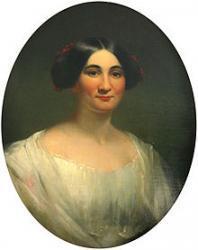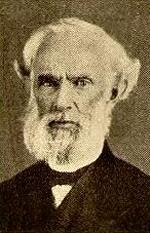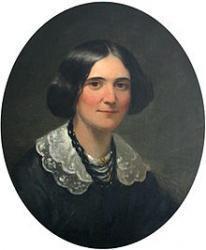Planning worship?
Check out our sister site, ZeteoSearch.org,
for 20+ additional resources related to your search.
- |
User Links
Person Results
Phoebe Cary

1824 - 1871 Author of "Nearer My Home" in Songs of the Kingdom Phoebe Cary, (1824-1871) was born and raised in Mount Healthy in Hamilton County, Ohio. Her family came from Lyme, New Hampshire to Ohio when her grandfather was given land in return for his service in the Continental Army. She was the younger sister of Alice Cary (1820-1871). She and Alice submitted poetry to religious periodicals. Phoebe remained in Ohio and continued to write many hymns, including, "One sweetly solemn thought."
Mary Louise VanDyke
===========================================
Cary, Phoebe, sister of Alice Cary, born near Cincinnati, Ohio, Sept. 4, 1824, and died within six months of the death of the same sister at Newport, July 31, 1871. Her works include Poems and Parodies, 1854; and Poems of Faith, Hope and Love, 1868. With Dr. Charles F. Deems she compiled Hymns for all Christians, 1869. Her hymns are:—
1. One sweetly solemn thought. Anticipation of Heaven. This piece was not intended for public use, nor is it a suitable metre for musical treatment, yet it has won universal acceptance and popularity. In some instances this has been attained by change of metre as in the Supplement to the Baptist Psalms & Hymns 1880, No. 1185. Johnson's Encyclopedia is in error in saying it was "written at the age of 17." The Congregational Quarterly for Oct., 1874, says, "it was written, she tells us, in the little back third story bedroom, one Sabbath morning in 1852, on her return from church." This statement shows that it was composed when she was 28, and not 17. The popularity of the hymn in Great Britain arose mainly through its use in the Evangelistic services of Messrs. Moody and Sankey. In the Protestant Episcopal Hymns for Church and Home, Phila., 1860, No. 383, it is given as "A sweetly solemn thought."
The following additional pieces by this author are in the Lyra Sacra Americana, 1868:—
2. Go and sow beside all waters. Seed Sowing.
3. Great waves of plenty rolling up. Gratitude.
4. I had drunk, with lips unsated. Living Waters.
[Rev. F. M. Bird, M.A.]
--John Julian, Dictionary of Hymnology (1907)
Phoebe Cary
Love H. Jameson

1811 - 1892 Person Name: L. H. Jameson Arranger of "I'm nearer my home" in New Christian Hymn and Tune Book Born: April 17, 1811, Jefferson County, Indiana.
Died: April 12, 1892, Indianapolis, Indiana.
Buried: Crown Hill Cemetery, Indianapolis, Indiana.
Love Humphreys Jameson was born in Jefferson County in what was then the Territory of Indiana on May 17, 1811, the son of Thomas Jameson. Thomas had moved from Virginia to Kentucky around 1800 and later to the Indiana Territory in 1810 or early 1811. Thomas’s parents were members of the Calvinistic Kirk of Scotland and his wife’s parents held the views of the Church of England, but the family became Christians in 1816 with Love’s father and mother being baptized by John McClung, a young associate of Barton Warren Stone. Love, whose education was attended with all the difficulties associated with frontier life and was mostly under the tuition of his parents, was baptized in the fall of 1829 during a protracted meeting with Beverly Vawter and then preached his first sermon that same year on Dec. 25, following which he began preaching the gospel regularly.
From 1830 to 1834, Jameson taught school during the winters and made preaching trips in the summers. One of his mentors was Walter Scott, with whom he frequently travelled and worked. Moving to southern Ohio, in 1834, he, along with Scott, attended the famous debate of 1837 between Alexander Campbell and Bishop Purcell at Cincinnati, OH. In addition, he wrote frequently for Campbell’s paper, The Millennial Harbinger, in which Campbell spoke of him as the brother “whose praise is in all the churches in Indiana.” After preaching at various churches in Hamilton County, OH, Jameson worked with the church in Dayton from 1835 to 1837, when he married Elizabeth M. Clark. Also, in the closing years of B. W. Stone’s life, Jameson often accompanied the elderly preacher on his journeys. In 1840 he returned to Indiana and located at Madison, IN, the following year. His wife died of an apoplectic stroke suddenly soon afterwards, and he married Elizabeth R. Robinson in 1842, moving to Indianapolis, IN, which became his headquarters for the rest of his life.
In 1845, Jameson was asked, along with John O’Kane, to evangelize in the southwestern part of the state. Then after 1854, he made regular preaching trips into Ohio, Kentucky, Western Missouri, Illinois, New York, and even portions of New England. “There is a Habitation” was penned about 1860, with both words and original music by Jameson, but it never achieved any degree of popularity because of its slow, ponderous, torpid melody. The song as we know it was first published under the title, “O Sion, Sion,” in the New Christian Hymn and Tune Book, Part II, compiled at Cincinnati, OH, in 1882 by James Henry Fillmore. Jameson, who also provided the lyrics for “Night, With Ebon Pinion,” died ten years later, on May 1, 1892, in Indianapolis.
--hymnstudiesblog.wordpress.com
Love H. Jameson
John M. Evans
Composer of "[One sweetly solemn thought]" in Songs of the Kingdom Evans, John M. (Hilltown, Pennsylvania, November 30, 1825--?). Baptist. Appointed superintendent of the Sunday School at Tenth Baptist Church, Philadelphia, in 1854. Under his direction, the Sunday School became the first in that city to make music a prominent feature of its activities. In 1872, he was elected President of the Baptist Sunday School Association of Philadelphia. Author of several hymns and tunes. Included in Devotional Hymn Book (Philadelphia, 1864) is the text "Amid the joyous scenes of earth" which is interesting in that the refrain is the same as the one for the Doddridge text "Oh, happy day, that fixed my choice."
--Deborah Carlton Loftis, DNAH Archives
John M. Evans
Alice Cary

1820 - 1872 Person Name: Alice Carey Author of "A Crown of Glory" in Westminster Sabbath School Hymnal, a collection of hymns and tunes for use in sabbath-schools and social meetings Alice Cary (1820-1871) was born and raised in Mount Healthy in Hamilton County, Ohio. Her family had come from Lyme, New Hampshire when her grandfather was given land in return for his service in the Continental Army. She had been nationally recognized as an interpreter of pioneer traditions. Her short story collections depict Mount Healthy as it was transformed from an isolated rural village to a Cincinnati suburb. She and her sister Phoebe wrote for local religious periodicals before Alice moved to New York City. John Greenleaf Whitier praised Alice's stories as "simple, natural, truthful [with] a keen sense of humor and pathos of the comedy and tragedy of life in the country." Her hymn "Along the mountain track of life" was published in H.W.Beecher's Plymouth Collection, 1856. Her hymn titled "Nearer Home" was published in W.A.Ogden's Crown of Life (Toledo, OH: Whitney, 1875).
Mary Louise VanDyke
======================================
Cary, Alice, the elder of two gifted sisters, was born near Cincinnati, Ohio, 1820, removed to New York in 1852, and died there Feb. 12, 1871. The story of the two sisters—of their courageous move from a rural, western home, their life in the metropolis, their mutual affection, and inability to live apart—has attracted much admiring and sympathetic interest. As poets they were of nearly equal merit. Besides some prose works, Alice published a volume of Poems in 1850. Her hymns are:—
1. Earth with its dark and dreadful ills. Death anticipated. This fine lyric is given in Hymns and Songs of Praise, N. Y., 1874, and dated 1870.
2. Along the mountain track of life. Lent. The authorship of this hymn, although sometimes attributed to Alice Cary, is uncertain. It appeared anonymously in H. W. Beecher's Plymouth Collection, 1855, No. 438. It would seem from its tone and the refrain, "Nearer to Thee," to have been suggested by Mrs. Adams's "Nearer, my God, to Thee," which appeared in 1841.
In addition to these there are the following hymns by her in the Lyra Sacra Americana, 1868:—
3. Bow, angels, from your glorious state. Peace desired.
4. I cannot plainly see the way. Providence.
5. Leave me, dear ones, to my slumber. Death anticipated.
6. Light waits for us in heaven. Heaven.
7. A crown of glory bright. His Fadeless Crown. In the Methodist Sunday School Hymn Book (London), 1879. [Rev. F. M. Bird, M.A.]
--John Julian, Dictionary of Hymnology (1907)
======================
Cary, Alice, p. 214, i. From her Ballads, Lyrics and Hymns, N.Y., 1866, the following are in Horder's Worship Song, 1905:—
1. O day to sweet religious thought. Sunday.
2. Our days are few and full of strife. Trust in God. The original begins, "Fall, storms of winter, as you may."
3. To Him Who is the Life of life. God and Nature.
--John Julian, Dictionary of Hymnology, New Supplement (1907)
Alice Cary


 My Starred Hymns
My Starred Hymns


